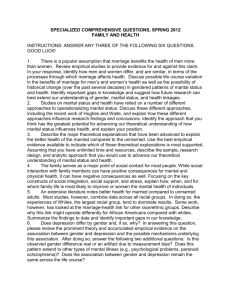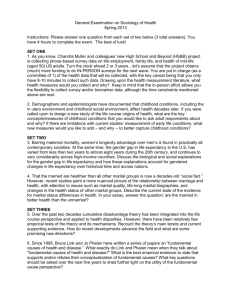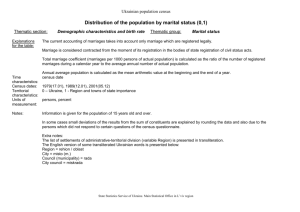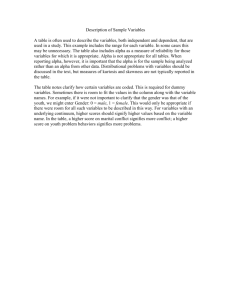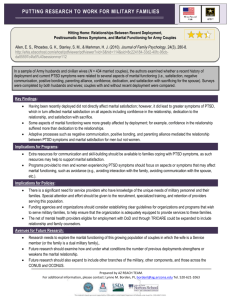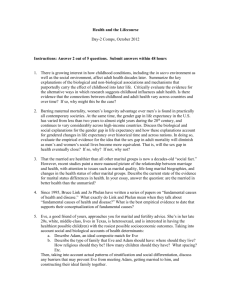Socio-Economic Heterogomy and Marital Satisfaction - Kamla
advertisement
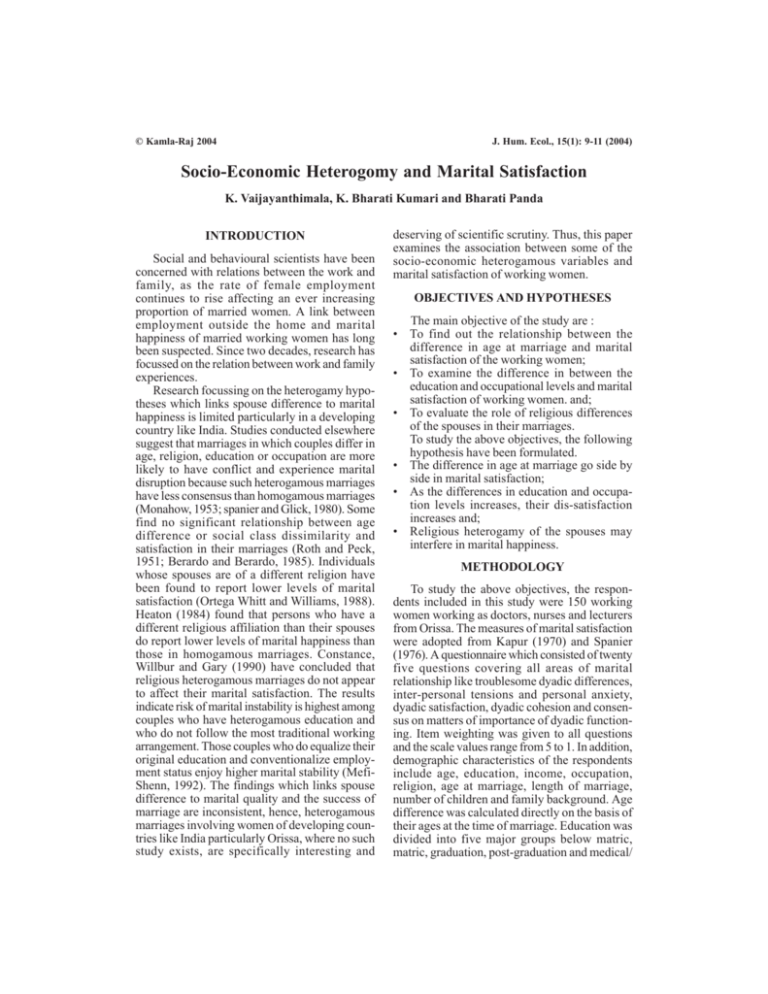
© Kamla-Raj 2004 J. Hum. Ecol., 15(1): 9-11 (2004) Socio-Economic Heterogomy and Marital Satisfaction K. Vaijayanthimala, K. Bharati Kumari and Bharati Panda INTRODUCTION Social and behavioural scientists have been concerned with relations between the work and family, as the rate of female employment continues to rise affecting an ever increasing proportion of married women. A link between employment outside the home and marital happiness of married working women has long been suspected. Since two decades, research has focussed on the relation between work and family experiences. Research focussing on the heterogamy hypotheses which links spouse difference to marital happiness is limited particularly in a developing country like India. Studies conducted elsewhere suggest that marriages in which couples differ in age, religion, education or occupation are more likely to have conflict and experience marital disruption because such heterogamous marriages have less consensus than homogamous marriages (Monahow, 1953; spanier and Glick, 1980). Some find no significant relationship between age difference or social class dissimilarity and satisfaction in their marriages (Roth and Peck, 1951; Berardo and Berardo, 1985). Individuals whose spouses are of a different religion have been found to report lower levels of marital satisfaction (Ortega Whitt and Williams, 1988). Heaton (1984) found that persons who have a different religious affiliation than their spouses do report lower levels of marital happiness than those in homogamous marriages. Constance, Willbur and Gary (1990) have concluded that religious heterogamous marriages do not appear to affect their marital satisfaction. The results indicate risk of marital instability is highest among couples who have heterogamous education and who do not follow the most traditional working arrangement. Those couples who do equalize their original education and conventionalize employment status enjoy higher marital stability (MefiShenn, 1992). The findings which links spouse difference to marital quality and the success of marriage are inconsistent, hence, heterogamous marriages involving women of developing countries like India particularly Orissa, where no such study exists, are specifically interesting and deserving of scientific scrutiny. Thus, this paper examines the association between some of the socio-economic heterogamous variables and marital satisfaction of working women. OBJECTIVES AND HYPOTHESES The main objective of the study are : • To find out the relationship between the difference in age at marriage and marital satisfaction of the working women; • To examine the difference in between the education and occupational levels and marital satisfaction of working women. and; • To evaluate the role of religious differences of the spouses in their marriages. To study the above objectives, the following hypothesis have been formulated. • The difference in age at marriage go side by side in marital satisfaction; • As the differences in education and occupation levels increases, their dis-satisfaction increases and; • Religious heterogamy of the spouses may interfere in marital happiness. METHODOLOGY To study the above objectives, the respondents included in this study were 150 working women working as doctors, nurses and lecturers from Orissa. The measures of marital satisfaction were adopted from Kapur (1970) and Spanier (1976). A questionnaire which consisted of twenty five questions covering all areas of marital relationship like troublesome dyadic differences, inter-personal tensions and personal anxiety, dyadic satisfaction, dyadic cohesion and consensus on matters of importance of dyadic functioning. Item weighting was given to all questions and the scale values range from 5 to 1. In addition, demographic characteristics of the respondents include age, education, income, occupation, religion, age at marriage, length of marriage, number of children and family background. Age difference was calculated directly on the basis of their ages at the time of marriage. Education was divided into five major groups below matric, matric, graduation, post-graduation and medical/ K. VAIJAYANTHIMALA, K. BHARATI KUMARI AND BHARATI PANDA 10 engineering. If the couples differ in education, then it is treated as educational heterogamy. Occupational homogamy is measured as couples who fall in the same occupation group, otherwise they belong to heterogamy. Another independent variable is religiosity, is measured by indicating whether the Hindu respondent is married to a nonHindu then it is a religious heterogamy. Means and regression analysis were used to ascertain whether any observed effect of heterogamy interact in affecting marital happiness. RESULT AND DISCUSSION Usually, in Indian traditional families, women are expected to marry men who are atleast 4-5 years older, men are more educated than their wives, earning more and in a good employment status and have the same religion. If couples violate these “norms”, they are more likely to break-up. Age at Marriage It is assumed that greater the difference in age between the spouses, the greater is the marital dissatisfaction. The average age difference between the spouse is about 4 years. Table 1 reports the mean values of age differences between the spouses and the satisfaction scores. Bernard (1934) observed that the women seem to be most satisfied with husbands of similar age or older to them by 1 to 5 years. The satisfaction diminishes as the age difference increases. Kapur (1970) found no association between age difference and marital adjustment. Marriages in which the husband is more than 3 years older than his wife are more likely to break up their age homogamous couples and older wife younger husband couples (Tweno, 1992). The mean values with reference to age heterogamy and marital satisfaction is consistent with most previous studies. Even the Table 1: Differences in age, education, occupation, religion of spouses and marital satisfaction scores Satisfaction level 25 – 46 – 66 – 86 – 106 – 45 65 85 105 125 Age difference 5.86 5.40 4.56 4.11 3.97 EducaOccuReligious tional pational difference difference difference 1.29 0.80 0.50 0.58 0.68 1.43 0.80 0.94 0.83 0.72 1.14 1.60 1.13 1.24 1.09 regression value indicates that there is a statistical significant difference (at 10% level) between age difference and marital satisfaction. Education Education is one of the important factor in mate selection and is the potential source of difference in marriage pattern. It is believed that where there is a great discrepancy in the educational status between the spouses, marital relationships become strained (Khanna and Varghese, 1978). The results of t-test sd (1992) show that the higher the educational attainment at the time of marriage for each spouse, the less likely they are to divorce. The models also indicate that educational heterogamous couples are in general more likely than homogamous couples to experience marital disruption. Even the results of the present study is in consistent with the above findings that with the increase in average education score of the spouses, the satisfaction score also showed an increasing trend. As per the table dissatisfaction is more where there is more difference in the educational levels of the spouses. The regression values also support the mean values that there is a significant difference (at 10%) level between the variable i.e., educational difference and marital satisfaction. Occupation Financial pressures pushed many women into the employment market. Such employment in most cases, is different in status and nature from the occupations of their husbands. This difference odds a new factor to the area of marital adjustment. The data confirms to the assumption that discre-pancies in the occupation of the spouses, create frictions in married life. Women who are found to be closer or equal to their husbands in occupa-tional status, appear to be happier in their marriages: Not only the mean values but also the regression values support that the women whose husbands are in different occupations seem to suffer most in marital adjustment and this is one of the strongest variable which interfere in marital satisfaction as the association is statistically significant at 2.5% level. Religion Individuals whose spouses are of a different SOCIO-ECONOMIC HETEROGOMY AND MARITAL SATISFACTION religious persuation than themselves have been found to report lower levels of marital satisfaction (Ortega et al., 1988). Heterogamy does not appear to affect spouses marital satisfaction adversely (Constance et al.,1990). The column of Table 2 includes coefficients for regression equation that contains the relationship between religiosity and heterogamy and reveals, being in an interfaith marriages does not significantly affect marital satisfaction. The present study is in agreement with the results of Constance, Wilbur and Gary. Table 2: Regression coefficients between variables and marital satisfaction S. No. Variable R2 1. 2. Age difference Educational difference Employment difference Religions difference 0.02 0.01 1.52 1.53 10% 10% 0.08 2.84 2.5% 0.01 1.15 No difference 3. 4. ‘t’ value Significant difference CONCLUSION The main value of this study lies in providing a relatively comprehensive analyses of some heterogamous factors like age, education, occupation and religiosity in marital satisfaction. The results suggest that the efforts of the above factors are, in large part, in agreement with prior research. In the present study heterogamous occupation is one of the strongest variable which influence marital satisfaction. The results also suggest that marital dissatisfaction is high among couples with heterogamous age and education. However, religious heterogamy suggest that the risk of marital instability is very less or not at all significant. In Orissa, no other emperical explanation has found for marital satisfaction with heterogamous 11 variables. These results provide a useful beginning for future researchers to replicate, using more representative samples. KEYWORDS Heterogomy. Consensus. Spouse Difference ABSTRACT In the present study, an attempt has been made to study the association between some of the socio-economic haterogamous variables and marital satisfaction of working women. Data were collected from the 150 working women, working as doctors, nurses and lecturers from the district of Orissa, India. REFERENCES Bernard, Jessie: Factors in the distribution of success Marriagep. American Journal of Sociology, 11 (1934). Chesser, E.: The Sexual, Marital and Family Relationship of English Women. Hutchinson’s Medical Publications, Great Britain (1956). Constance, L., Shehau, E., Wilber, Book and Gray, R. Lee: Religious heterogamy, religiosity of Marital happiness: The case of Catholics. Journal of Marriage and Family, 52: 73-79 (1990). Heaton, Tim B.: Religious Homogamy and marital satisfaction reconsidered. Journal of Marriage and the Family, 46: 729-733 (1984). Kapur, P.: Marriage and Working Women in India. Vikas Publications, New Delhi (1970). Kala, Rani: Performance of job role by working women. The Indian Journal of Social Work, 3: 291-291 (1976). Khanna, S. and Varghese, A. Mariamma: Indian Women Today. Vikash Publication, New Delhi (1978). Mefi-Shenn, Tzfng: The efforts of socio-economic heterogamy and changes on marital dissolution for first marriages. Journal of Marriage and the Family, 54: 609-619 (1992). Ortega, Suzanne T., High P. Whitt and Williams, J. Allen Jr.: Religious homogamy and Marital Happiness. Journal of Family Issues, 9: 224-239 (1988). Roth, J. and Peck, R.F.: Social class and social mobility factors related to marital adjustment. American Sociological Review, 16: 478-492 (1951). Spanier, Grahom B.: Measuring Dyadic adjustment: New scales for assessing the quality of marriage and similar dyads. Journal of Marriage and Family, 38: 15-29 (1976). Spanier, G. and Glick, P.: The life cycle of American families: An expanded analysis. Journal of Divorce, 3: 283-298 (1980). Authors’ Addresses: K. Vaijayanthimala, Department of Home Science, Women’s College, Berhampur 760 001, Orissa, India K. Bharati Kumari, Department of Psychology, Jamia Millia Islamia University, New Delhi, India Bharati Panda, P.G. Department of Home Science, Sambalpur University, JV, Burla 768 019, Orissa, India

